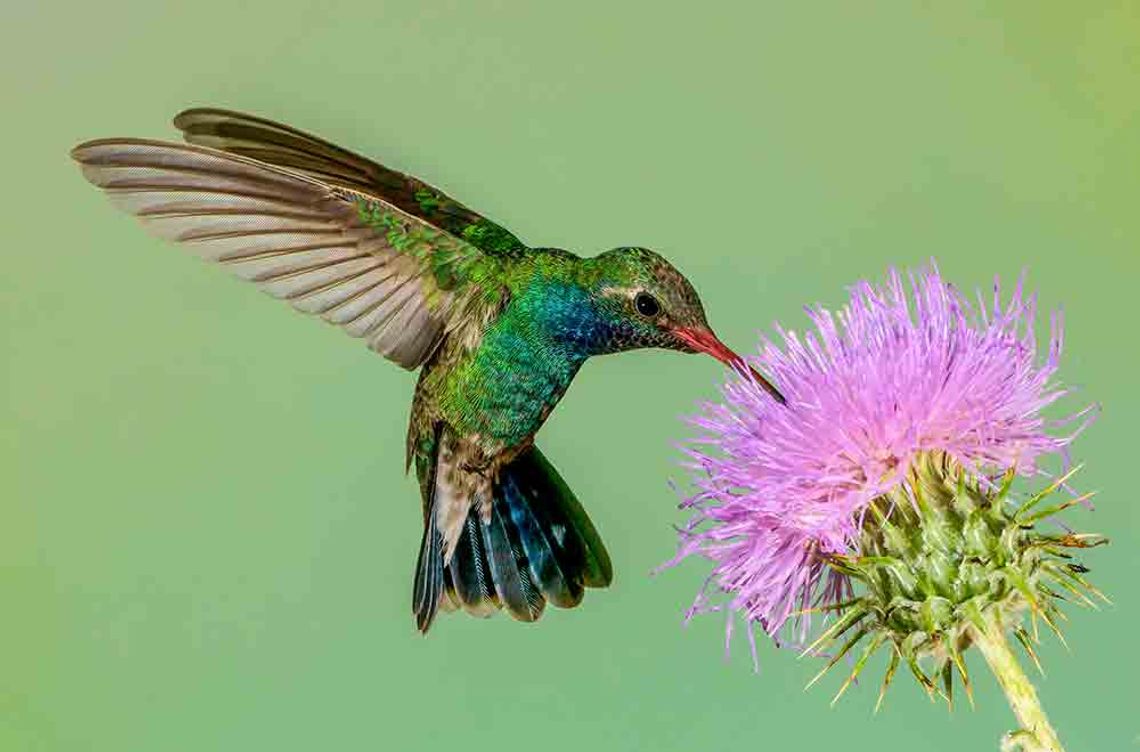By Maureen Peltier
With fall soon arriving in Tyler County, we are about to lose a common sight – our colorful, often entertaining, sometimes mean and aggressive Ruby-throated Hummingbirds.
While they are still here, notice the males’ bright emerald backs and brilliant iridescent red throats as they fly forward, backward, sideways, up, down and in circles.
Their miraculous flying abilities are vastly disproportionate to their three-inch wingspans and three-inch height. Like airborne jewels fluttering at more than 70 strokes per second, their wings seem invisible as they suspend themselves in midair.
Weighing less than a nickel, these aerial acrobats are preparing to embark on a 500–600-mile flight across the Gulf of Mexico or along the Texas coast to their winter homes in areas from the south of Mexico to Costa Rica.
Evidence shows that hummingbirds sometimes use tail winds to help reach their destination faster. Research also indicates that a hummingbird can travel as much as 23 miles in one day. However, during migration as they cross the Gulf of Mexico they may cover up to 500 miles at a time.
Pretty soon, start watching for more hummers than usual, as millions migrate through Texas from their breeding grounds as far north as Nova Scotia. In preparation for these flights, they will be doubling their weight. If you have feeders out, don’t take them down until two weeks after you see the last hummer – a straggler might come by needing to top off his tank.
If you consistently put out feeders or have colorful flowers in your yard, they know you and your yard. That would be because hummingbirds have an excellent memory and can locate the feeders they have used in the past and, it is said, even recognize people. Yes, the same birds you have been consistently feeding this year may very well be back to dine with you, come next March when they return.
A word of caution - if the feeders they seek are not out, they may go somewhere else and never return.
These creatures are wondrous, if you have not noticed. They don’t fly like normal birds. They zoom - at speeds up to 30 miles an hour. The males reach 65 feet per second when they are courting, climbing high into the air and then diving past the females while making loud noises with their tail feathers.
The hummingbird is the smallest of all the birds - its brain makes up over four percent of its weight, proportionally the largest of any bird. Inside that big little brain is a veritable encyclopedia of lifesaving information. Studies have shown that hummingbirds can remember every flower they’ve ever visited, including those on their migration routes. They know how long to wait between visits to specific areas so that flowers have nectar ready for them. It is even believed that they can recognize humans. You may know a neighbor or friend who could get a hummingbird to land on her hand, but when you tried the same thing, the bird would not cooperative.
What else besides their brain helps them do that? Their terrific vision. They can see every color we can, plus. Unlike ours, their eyes can process ultraviolet light. Zooming at such speeds, they have three translucent protective flaps of skin over their eyes that act like natural flight goggles.
According to research, a hummingbird’s metabolic demands are so high that it must enter into a state of torpor to survive overnight without food. That would be why they are especially active in the morning and evening hours. Other than at night, like marathon runners, hummingbirds have super-fast metabolisms and need to eat constantly —about every 10 minutes. Estimates vary, but it is believed that they generally eat two to three times their body weight every day.
With flowers and feeders, it is the bright colors that attract them. Try wearing a bright red cap among them sometime, and they may very well give you a peck. They do not rely entirely on nectar from their favorite flowers, but also on insects and spiders
All the while, they have to remain wary of their predators like blue jays and kestrels, as well as frogs and praying mantises that eat their eggs. Nighttime presents other hazards, including squirrels and small rodents which attack the birds as they sleep and eat their eggs. Here in this area, though, their normal life spans are shortened more often by our cats and surprise collisions with windows.
Despite that, they can live up to 12 years, provided they don’t meet an accidental death, fall victim to those predators or suffer from severe weather conditions. Their average lifespan is three to five years.
Not surprisingly, these feathered aviators are antisocial. The only time two will be found together is during the few minutes it takes to find a mate and copulate. Then the male is back to arguing with other hummers while defending his food source, and the female is busy building a nest and raising the young, alone.
The female, after fertilization by a male, builds a small nest about an inch deep, most commonly on a tree or shrub branch, and lays one to three eggs, smooth, white, and the size of jellybeans. The young birds leave the nest 18-22 days later. If a female’s nest lasts the winter while she is gone south, she may even reuse it when she returns. That alone is a good example of the memory these birds have!
There are 320 species of hummingbirds worldwide, eighteen of which can be found in North America and nine in Texas. Here in East Texas, we have only one species, the Ruby-throated. So little birds, goodbye soon and have a safe trip. We’ll miss you - please come back to see us next year. Your feeders will be in the same places they were this year, we promise.











Comment
Comments